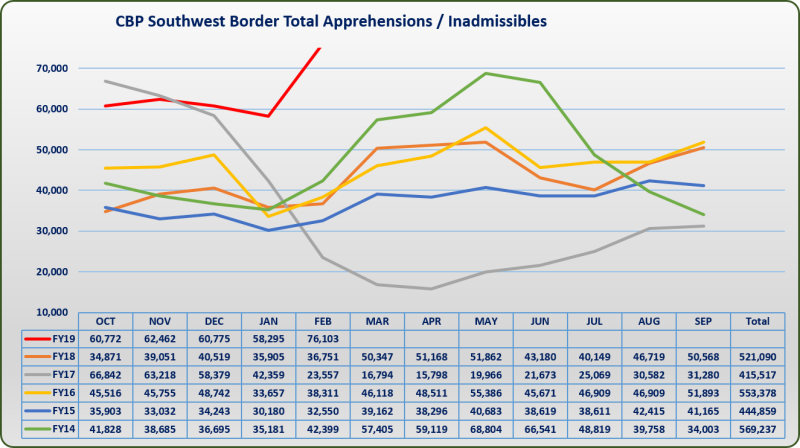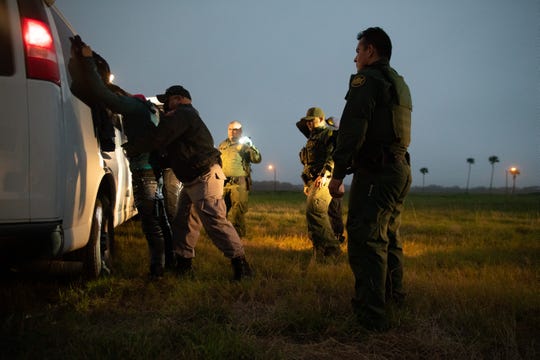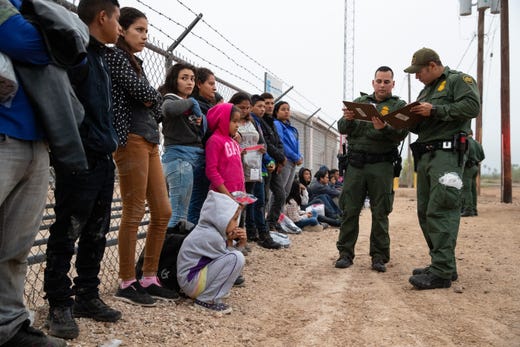Border Patrol: 300 percent spike in family apprehe
Post# of 65629

March 5, 2019
Video: https://www.usatoday.com/story/news/politics/...070451002/
The number of families crossing into the United States is driving the largest number apprehensions at the southern border since 2005.
Apprehensions of migrants along the nation's southern border are the highest in more than a decade, creating what the top U.S. Customs and Border Protection official described Tuesday as a mushrooming crisis that threatens to overwhelm federal authorities.
The influx is being driven by a 300 percent increase in the number of people crossing as part of families compared with 2018. Families, along with unaccompanied children, accounted for 60 percent of all apprehensions since Oct. 1.
"We are currently facing both a border security and humanitarian crisis along our southwest border," Customs and Border Protection Commissioner Kevin McAleenan told reporters.
During the five-month period ended Feb. 28, Border Patrol officers apprehended some 268,000 migrants who entered the United States without legal authorization. More than 76,000 entered in February alone.

https://www.cbp.gov/newsroom/stats/sw-border-migration
In the El Paso sector, which stretches from the westernmost border counties of Texas through all of New Mexico, apprehensions were up 434 percent from the previous year.
People entering as part of family units are outpacing the number of those entering by themselves or in groups on non-relatives, said Brian Hastings, the chief of Border Patrol operations, who joined McAleenan at the briefing.
The Border Patrol, Hastings said, "has no reason to expect this trend to decrease. In fact, it will increase."

Border Patrol Agents take in to custody migrants shortly after crossing the river from Mexico near Mission TX, on Tuesday, Feb. 28, 2019.
The briefing came as the U.S. Senate nears a vote on a House-passed resolution to overturn President Donald Trump's declaration of a state of emergency on the southern border so that he may divert federal funds toward the effort to construct more physical barriers that he said would help stem illegal immigration.
More apprehensions are taking place in the remote and rugged deserts of New Mexico and Arizona, far away from medical facilities and transportation systems, Hastings said. And more migrants are coming as part of large groups.
So far during the fiscal year that started in October, authorities have apprehended 70 groups that numbered 100 people or more. The year before, there were 13 such groups. And the year before that there were two, Hastings said.
If the present trend holds, he said 174 groups of 100 or more, totaling about 29,000 people, will be taken into custody by federal authorities by the end of the current fiscal year.

A migrant is searched before being transported after being taken in to custody by Border Patrol near Mission, Texas, after tracking them trough a field on Tuesday, Feb. 29, 2019.
Unlike earlier in the 2000s and before, most undocumented migrants are not from Mexico. About 70 percent, Hastings said, are from what he called the Northern Triangle of Central America: El Salvador, Guatemala and Honduras.
Apprehensions are on pace to be the largest since 2005, Hastings said. According to Border Patrol statistics, apprehensions on the southern border reached nearly 1.18 million that year.
The present appearance of large groups of migrants has also provided cover for drug traffickers because so many agents are needed to process group members, screen them for medical conditions and transport them to detention facilities, Hastings said.
"That's highly concerning for us going forward," he said.
Meanwhile, with authorities taking in an average of 55 people per day who need immediate medical attention, Customs and Border Protection plans to expand medical support in what Hastings and McAleenan described as "high-risk locations at and between ports of entry." This will include facilities for medical assessments that will be staffed by registered nurses and nurse practitioners.
The agency’s efforts to care for migrants has been under scrutiny ever since three migrants died in custody in three months, including two young children from Guatemala. The child deaths prompted Department of Homeland Security Secretary Kirstjen Nielsen to order medical screenings for all children in custody, but questions have continued about the agency’s willingness, or ability, to adequately care for migrants.
The spike in apprehensions is straining Border Patrol staff, Hastings said.
"The current situation is unsustainable."

Border Patrol Agent Hermann Rivera climbs through a fence as he assists other agents searching an area in Mission, Texas, for five migrants who ran from agents on Tuesday, Feb. 28, 2019.

A large group of migrant family wait along the side of the road to be transported after turning themselves in to Border Patrol agents in Penitas, Texas, on Tuesday, Feb. 26, 2019.

Border Patrol Agent Hermann Rivera talks with a 22-year-old women from El Salvador and her 5 and 3-year-old children after crossing the Rio Grande Valley from Mexico near Mission, Texas, on Tuesday, Feb. 26, 2019.
https://www.usatoday.com/story/news/politics/...070451002/
 (0)
(0) (0)
(0)